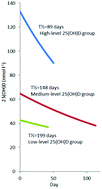The half-life of 25(OH)D after UVB exposure depends on gender and vitamin D receptor polymorphism but mainly on the start level
Abstract
The 25-hydroxy vitamin D (25(OH)D) production caused by UVB exposure is usually underestimated as the concurrent degradation of 25(OH)D is not considered. Therefore, the decrease in 25(OH)D was investigated during a 7-week period in winter when ambient UVB is negligible. Twenty-two healthy Danish individuals (113 samples) participated and had a mean and steady maximal 25(OH)D start level of 132 nmol l−1 (range of 68–216 nmol l−1) due to long-term UVB treatment prior to this study. In this group with high 25(OH)D start levels, the decrease in 25(OH)D was best described by an exponential model. This suggests a quantitatively larger elimination of 25(OH)D at high 25(OH)D start levels. A linear model (logarithm of 25(OH)D) including personal start levels as intercepts and a slope influenced by gender and the vitamin D receptor gene polymorphism rs2228570 explained 87.8% of the observed variation. The mean half-life was 89 days with a difference in half-life of 120 days between a male with rs2228570 genotype GG (59 days) and a female with rs2228570 genotype AA/AG (179 days). Thus, these two parameters explained a large part of the observed inter-individual variation of 25(OH)D. Furthermore, the decrease was analysed in two groups with medium and low 25(OH)D start levels resulting in longer half-lives of 149 days and 199 days, respectively. The longer half-lives at lower 25(OH)D levels may be caused by storage mobilisation, changed catabolism or increased intestinal absorption.



 Please wait while we load your content...
Please wait while we load your content...